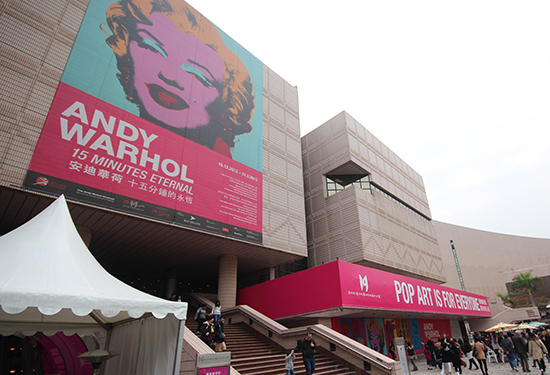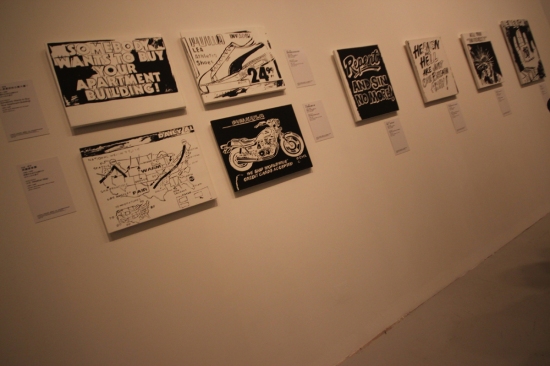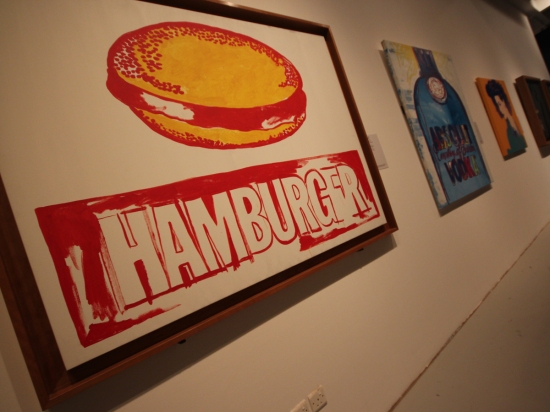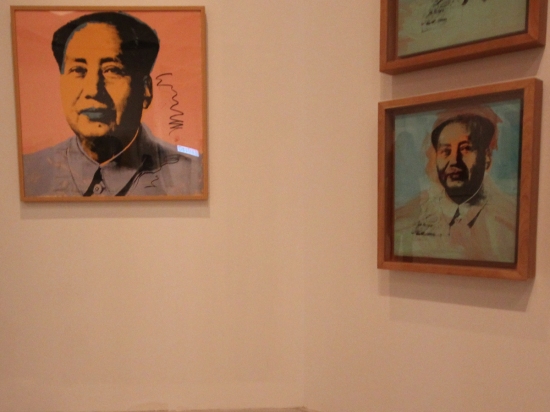Everyone has a favourite Warhol. You can’t deny it. It’s advertising in its purest form, there’s always one piece of his cleverly mass produced art that draws us in. From a psychological standpoint I’m sure many would point to my mother-son relationship and love of a strong woman but for me my choice is always “Queenie”. I dare describe HRH Queen Elizabeth II in this way because she has been reduced to such an exceedingly plebeian fashion as to bring her to the masses, namely me, on my own terms (Blackadder-esque)… but let’s rewind for a second and take a closer look at just how this happened, who Andy Warhol was, how he achieved my audience and what this exhibition is all about?
 A native of Pittsburgh, Pennsylvania, his father of Slovakian descent and Catholic faith emigrated to the U.S.A in the first decade of the 1900’s. Sensitive, artistic and a victim of chorea, an involuntary muscular disease at the tender age of 8, Warhol was an outcast at school. Commonly bed-ridden, his mother gave him his first drawing lessons, which he quickly took to while building a collection of movie stars – a now recognised influential period to the development of his skill-set. In 1949 he moved to NYC and rapidly became one of the most commercially sought after illustrators on the advertising circuit. By 1952 he held his first show in Hugo Gallery and emerged as a key component in the developing pop art movement. In 1964 he started the silver painted and foil draped studio known as The Factory. His shooting in 1968 by feminist writer Valerie Solanas forced reclusion on this otherwise centre of the party figure, regularly surrounded by the rich and famous. The 70’s saw a much quieter decade where Warhol cemented his commercial success with multiple commissions while partaking in celebrity saturation at Studio 54. It was in his final decade the 1980s where his affiliation with a number of younger artists including Basquiat gave his work new credence to the general public despite a number of critical reviews describing him as facile and “with no depth or indication of the significance of their subjects”. Perhaps these critics just didn’t get it at the time, but to me it seems that’s exactly what he was aiming for…
A native of Pittsburgh, Pennsylvania, his father of Slovakian descent and Catholic faith emigrated to the U.S.A in the first decade of the 1900’s. Sensitive, artistic and a victim of chorea, an involuntary muscular disease at the tender age of 8, Warhol was an outcast at school. Commonly bed-ridden, his mother gave him his first drawing lessons, which he quickly took to while building a collection of movie stars – a now recognised influential period to the development of his skill-set. In 1949 he moved to NYC and rapidly became one of the most commercially sought after illustrators on the advertising circuit. By 1952 he held his first show in Hugo Gallery and emerged as a key component in the developing pop art movement. In 1964 he started the silver painted and foil draped studio known as The Factory. His shooting in 1968 by feminist writer Valerie Solanas forced reclusion on this otherwise centre of the party figure, regularly surrounded by the rich and famous. The 70’s saw a much quieter decade where Warhol cemented his commercial success with multiple commissions while partaking in celebrity saturation at Studio 54. It was in his final decade the 1980s where his affiliation with a number of younger artists including Basquiat gave his work new credence to the general public despite a number of critical reviews describing him as facile and “with no depth or indication of the significance of their subjects”. Perhaps these critics just didn’t get it at the time, but to me it seems that’s exactly what he was aiming for…
 The Hong Kong Museum of Art, in existence since 1962, is the fundamental art museum of the territory. Originally housed at City Hall in Central it now sits next to The Space Museum on Salisbury Road, TST. Now I recognise that HK doesn’t have the longest of histories, but my word is it interesting; full of intrigue, adventure and dare I say it shame. Malevolence and pure commercial trade with no aforethought for the consequences of action? That sounds like a great film that Warhol would be proud of, and yet the permanent exhibitions here ex-Xubaizhai are nothing short of a snooze-fest. My feeling has always been “wake up curators and let’s whip up excitement about some of the talented art that has been and continues to be produced in this phenomenally frenetic place that remains the doorway to China”; so was this the start of something at last? And so, Ladies and Gentlemen, it was for the first time with glee and a swing in my step I headed to this musty outpost of culture, which regularly stands in the shadow of the Cultural Centre right next door.
The Hong Kong Museum of Art, in existence since 1962, is the fundamental art museum of the territory. Originally housed at City Hall in Central it now sits next to The Space Museum on Salisbury Road, TST. Now I recognise that HK doesn’t have the longest of histories, but my word is it interesting; full of intrigue, adventure and dare I say it shame. Malevolence and pure commercial trade with no aforethought for the consequences of action? That sounds like a great film that Warhol would be proud of, and yet the permanent exhibitions here ex-Xubaizhai are nothing short of a snooze-fest. My feeling has always been “wake up curators and let’s whip up excitement about some of the talented art that has been and continues to be produced in this phenomenally frenetic place that remains the doorway to China”; so was this the start of something at last? And so, Ladies and Gentlemen, it was for the first time with glee and a swing in my step I headed to this musty outpost of culture, which regularly stands in the shadow of the Cultural Centre right next door.
 Pop art actually began in Britain, not America, believe it or not, but their academic analysis from afar vs America’s innate understanding saw the latter really nurture the movement. With great emphasis that I am not patronising my readers, pop is obviously short for popular and was no doubt a shot across the bow of “fine” art, which even to this day is viewed externally by some as a closed society of navel-gazing academics, high flying curators, forcibly trend-setting gallerists, cartelizing auction houses to name but a few. Drawing its source material from advertising, comics and everyday mundane items, Pop art was considered a reaction to abstract expressionism, made famous in Warhol’s NYC by the likes of Jackson Pollock amongst others. I can think of no better way of describing the movement itself than in Warhol’s own words:
Pop art actually began in Britain, not America, believe it or not, but their academic analysis from afar vs America’s innate understanding saw the latter really nurture the movement. With great emphasis that I am not patronising my readers, pop is obviously short for popular and was no doubt a shot across the bow of “fine” art, which even to this day is viewed externally by some as a closed society of navel-gazing academics, high flying curators, forcibly trend-setting gallerists, cartelizing auction houses to name but a few. Drawing its source material from advertising, comics and everyday mundane items, Pop art was considered a reaction to abstract expressionism, made famous in Warhol’s NYC by the likes of Jackson Pollock amongst others. I can think of no better way of describing the movement itself than in Warhol’s own words:
“What’s great about this country is that America started the tradition where the richest consumers buy essentially the same things as the poorest. You can be watching TV and see Coca-Cola, and you know that the President drinks Coca-Cola, Liz Taylor drinks Coca-Cola, and just think, you can drink Coca-Cola, too. A Coke is a Coke and no amount of money can get you a better Coke than the one the bum on the corner is drinking. All the Cokes are the same and all the Cokes are good. Liz Taylor knows it, the President knows it, the bum knows it, and you know it.”
 Just as Michael Jackson earned the nomenclature The King of Pop, Andy Warhol equally deserves “The Prince of Pop Art”; and if you didn’t already recognise it, it is here at The Art Amateur we hope to demonstrate why. This exhibition based on a 1968 quotation from Andy Warhol “In the future, everyone will be world-famous for 15 minutes” marks the 25th anniversary of his death and I would like to thank The Andy Warhol Museum, Pittsburgh in particular for allowing the loan of a majority of their collection to such a far flung region in Asia! I know I am extremely grateful to see over 450 pieces of photographs, films and paintings and especially Time Capsule 23, which contained a number of personal items that Warhol collected during his visit to HK and Beijing in 1982! One large criticism, though I do want to air, so let’s get it over with now. Why oh why the anal retentiveness towards photos HKMoA? No flash photography for delicate items fine, but concerns over copyright are just laughable when it comes to the most widely distributed artist of the 20th century.
Just as Michael Jackson earned the nomenclature The King of Pop, Andy Warhol equally deserves “The Prince of Pop Art”; and if you didn’t already recognise it, it is here at The Art Amateur we hope to demonstrate why. This exhibition based on a 1968 quotation from Andy Warhol “In the future, everyone will be world-famous for 15 minutes” marks the 25th anniversary of his death and I would like to thank The Andy Warhol Museum, Pittsburgh in particular for allowing the loan of a majority of their collection to such a far flung region in Asia! I know I am extremely grateful to see over 450 pieces of photographs, films and paintings and especially Time Capsule 23, which contained a number of personal items that Warhol collected during his visit to HK and Beijing in 1982! One large criticism, though I do want to air, so let’s get it over with now. Why oh why the anal retentiveness towards photos HKMoA? No flash photography for delicate items fine, but concerns over copyright are just laughable when it comes to the most widely distributed artist of the 20th century.
 The first room in the museum was a great introduction to the maestro’s works and laid the foundation clearly and succinctly on how this young talent quickly rose through the ranks of New York’s advertising society. Now I can only comment for myself, but we’re talking the world of Mad Men, Lionsgate’s excellent take on 50’s era advertising and while I thought it most likely not an easy industry for a gay eccentric man of Warhol’s tendencies to be part of – think Salvatore Romano – it was fascinating to read David Leddick’s take in the Huffpost (http://tinyurl.com/8yjth66) who said in actual fact only few agencies were this stuffy and many allowed gays to thrive. It was at I. Miller where his detailed designs of shoes earned him respect as one of the best inventors in his product and saw him earn as much as $50,000 a year by the mid-1950s, equivalent to over $400,000 today. Students and designers alike would have been fascinated by and no doubt interested in, as was I, a fuller picture of the world-renowned artist’s early creative side of his career.
The first room in the museum was a great introduction to the maestro’s works and laid the foundation clearly and succinctly on how this young talent quickly rose through the ranks of New York’s advertising society. Now I can only comment for myself, but we’re talking the world of Mad Men, Lionsgate’s excellent take on 50’s era advertising and while I thought it most likely not an easy industry for a gay eccentric man of Warhol’s tendencies to be part of – think Salvatore Romano – it was fascinating to read David Leddick’s take in the Huffpost (http://tinyurl.com/8yjth66) who said in actual fact only few agencies were this stuffy and many allowed gays to thrive. It was at I. Miller where his detailed designs of shoes earned him respect as one of the best inventors in his product and saw him earn as much as $50,000 a year by the mid-1950s, equivalent to over $400,000 today. Students and designers alike would have been fascinated by and no doubt interested in, as was I, a fuller picture of the world-renowned artist’s early creative side of his career.
 The collection of art itself was nothing short of excellent and the layout was chronological. In the first room we entered, we were greeted by an apparent re-enactment of The American Supermarket, the famed show held in Paul Bianchini’s Upper East Side Gallery in 1964. Items were laid out as you’d expect in an everyday manner and consisted of a number of boxes including Brillo and of course Campbell’s soup, but I was fairly underwhelmed by the curation. The chief curator should have made this a little bit more like the original location and with a bit of extra effort it could have been really fun rather than a simple shelf with items on it.. The American Supermarket was an important pre-cursor to the inevitable question that surrounded his work, “what is art?”, so here’s a small admonishment for not giving it a little more thought.
The collection of art itself was nothing short of excellent and the layout was chronological. In the first room we entered, we were greeted by an apparent re-enactment of The American Supermarket, the famed show held in Paul Bianchini’s Upper East Side Gallery in 1964. Items were laid out as you’d expect in an everyday manner and consisted of a number of boxes including Brillo and of course Campbell’s soup, but I was fairly underwhelmed by the curation. The chief curator should have made this a little bit more like the original location and with a bit of extra effort it could have been really fun rather than a simple shelf with items on it.. The American Supermarket was an important pre-cursor to the inevitable question that surrounded his work, “what is art?”, so here’s a small admonishment for not giving it a little more thought.
 A much better thought out room to which I do have to give the curators credit was an attempt at the famed silver warehouse where Warhol pioneered the use of film in art. Covered in foil and painted in silver, there were several looped videos including Eat but the one that caught my attention was the 1964 silent slow motion film Empire. Originally planned to be an eight hour movie, it actually became eight hours and five minutes due to a mistake made by Rob Trains the projectionist. Warhol for whatever reason was happy with the result however and with favourable reviews from the New York Times, decided to keep the final product. Never meant to be abridged in any way, it was the unwatchability of the film that Warhol emphasised. Several photos adorned the walls of the Warhol superstars, which included Baby Jane Holzer, Edie Sedgwick and others.
A much better thought out room to which I do have to give the curators credit was an attempt at the famed silver warehouse where Warhol pioneered the use of film in art. Covered in foil and painted in silver, there were several looped videos including Eat but the one that caught my attention was the 1964 silent slow motion film Empire. Originally planned to be an eight hour movie, it actually became eight hours and five minutes due to a mistake made by Rob Trains the projectionist. Warhol for whatever reason was happy with the result however and with favourable reviews from the New York Times, decided to keep the final product. Never meant to be abridged in any way, it was the unwatchability of the film that Warhol emphasised. Several photos adorned the walls of the Warhol superstars, which included Baby Jane Holzer, Edie Sedgwick and others. I was more than a little disappointed though by Silver Clouds. A collection of helium-filled mylar balloons, a recreation of the 1966 version at the Leo Castelli Gallery was effectively used as a children’s playpen. Now I am all for getting kids involved in art, but several of the balloons were basically deflated if not stamped on and I saw no-one actively educating the young in what this exhibit was about. Perhaps I’m wrong here but isn’t that the entire purpose of making an interactive exhibit? I was told from a friend on a quieter day that the balloons floated in a rather whimsical and playful manner. The paradox of a metal like object actually being light and easily moveable is no doubt what Warhol was going for here and it’s great that the kids were encouraged to get involved; but given the militant attitude of the guards towards photography I would have thought a little more focus on guiding the children would have allowed adults to also enjoy this exhibit, which I avoided altogether.
I was more than a little disappointed though by Silver Clouds. A collection of helium-filled mylar balloons, a recreation of the 1966 version at the Leo Castelli Gallery was effectively used as a children’s playpen. Now I am all for getting kids involved in art, but several of the balloons were basically deflated if not stamped on and I saw no-one actively educating the young in what this exhibit was about. Perhaps I’m wrong here but isn’t that the entire purpose of making an interactive exhibit? I was told from a friend on a quieter day that the balloons floated in a rather whimsical and playful manner. The paradox of a metal like object actually being light and easily moveable is no doubt what Warhol was going for here and it’s great that the kids were encouraged to get involved; but given the militant attitude of the guards towards photography I would have thought a little more focus on guiding the children would have allowed adults to also enjoy this exhibit, which I avoided altogether.
 As we progressed into the other side of the exhibit we entered the 1970s and 1980s where Warhol started experimenting with other materials including acetate collages of Mohammed Ali, the same year self-portraits in arylic and silkscreen ink on linen and indeed even a canvas primed with copper-based paint that he had assistants urinate on known as Oxidation Painting! Despite some groans at the balloon room though, every cloud does have its silver lining and I really enjoyed the children’s section that showcased works for the young’uns. Hung purposefully at a more appropriate height, Warhol created these smaller editions originally for a 1983 exhibition at Zurich’s Galerie Bruno Bischofberger and it was recreated well here.
As we progressed into the other side of the exhibit we entered the 1970s and 1980s where Warhol started experimenting with other materials including acetate collages of Mohammed Ali, the same year self-portraits in arylic and silkscreen ink on linen and indeed even a canvas primed with copper-based paint that he had assistants urinate on known as Oxidation Painting! Despite some groans at the balloon room though, every cloud does have its silver lining and I really enjoyed the children’s section that showcased works for the young’uns. Hung purposefully at a more appropriate height, Warhol created these smaller editions originally for a 1983 exhibition at Zurich’s Galerie Bruno Bischofberger and it was recreated well here.
 So what was my favourite picture of the exhibition? The one above hands down. The gravitas of the picture without doubt comes from the knowledge of Warhol’s shooting by Solanas, the fact that this was the exact gun which shot him and the deep affect it had on him and his work. Close friend and collaborator Billy Name after the attack called him “the Cardboard Andy” and Warhol said it confirmed later that his life was indeed like watching television – you don’t feel anything. All in I have to say I was on the whole very impressed with this exhibition. While I’m sure it’s experience in Singapore previously and its tour of the United States has already created a honed and polished machine, I did think there was a healthy amount of local relevance and I gather in Singapore they even had three artists showcase their works to highlight the global reach Warhol has had even in Southeast Asian art. I thought a nice final touch was a photo booth for visitors to take instant Warholian polaroids – what better way of having your eternal 15 minutes of fame?
So what was my favourite picture of the exhibition? The one above hands down. The gravitas of the picture without doubt comes from the knowledge of Warhol’s shooting by Solanas, the fact that this was the exact gun which shot him and the deep affect it had on him and his work. Close friend and collaborator Billy Name after the attack called him “the Cardboard Andy” and Warhol said it confirmed later that his life was indeed like watching television – you don’t feel anything. All in I have to say I was on the whole very impressed with this exhibition. While I’m sure it’s experience in Singapore previously and its tour of the United States has already created a honed and polished machine, I did think there was a healthy amount of local relevance and I gather in Singapore they even had three artists showcase their works to highlight the global reach Warhol has had even in Southeast Asian art. I thought a nice final touch was a photo booth for visitors to take instant Warholian polaroids – what better way of having your eternal 15 minutes of fame?
I couldn’t possibly end it without a few extra photos of the truly visual Warhol, so here are some special selections by the Royal I:
The Art Amateur
16th December – 31st March 2013
The Hong Kong Museum of Art
15 Minutes Eternal – Andy Warhol
10 Salisbury Road,
Tsim Sha Tsui,
HONG KONG
+852 2721 0116




